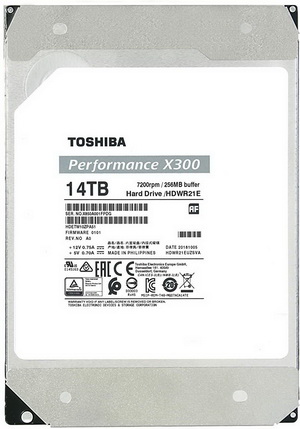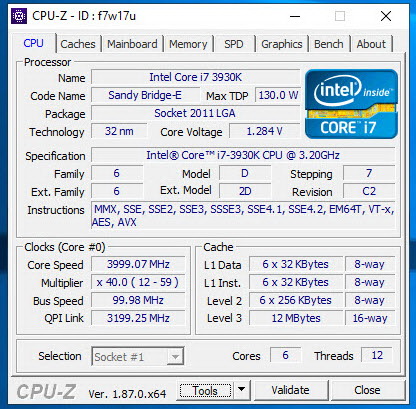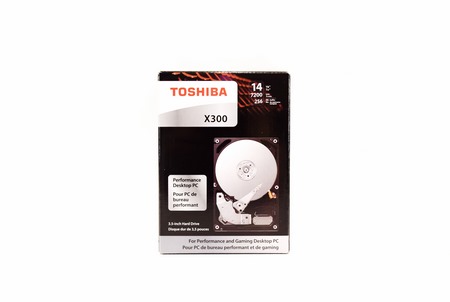INTRODUCTION

M.2 PCIe 3.0/4.0 solid state drives may hold the title of the fastest storage media around currently but in terms of capacity nothing can compare the classic hard disk drives. Now as some of you are aware a couple of years ago, we predicted that by the end of 2020 Seagate, WD and Toshiba would all have 20TB models in the market (some even 22TB ones) and so when WD announced early sampling of their 18-20TB models last September our prediction came true. Still WD is the only one of these three manufacturers to announce sampling of 18-20TB drives since the highest capacity models by both Seagate and Toshiba are currently 16TB ones (at least officially). Toshiba was actually the last manufacturer to announce availability of 14-16TB capacity models and today with us we have their high-performance desktop mode, the X300 14TB.
Toshiba Electronics Europe GmbH (TEE) is the European electronic components business of Toshiba Electronic Devices and Storage Corporation. TEE offers a broad IC and discrete product line including high-end memory, microcontrollers, ASICs and ASSPs for automotive, multimedia, industrial, telecoms and networking applications. The company also has a wide range of power semiconductor solutions as well as storage products including HDDs, SSDs, SD Cards and USB sticks. TEE was formed in 1973 in Neuss, Germany, providing design, manufacturing, marketing and sales and now has headquarters in Dusseldorf, Germany, with branch offices in France, Italy, Spain, Sweden and the United Kingdom. TEE employs approximately 300 people in Europe. Company president is Mr. Akira Morinaga.
The X300 family of SATA III 3.5" hard disk drives is currently available in 4/5/6/8/10/12/14/16TB capacities with the 12/14/16TB models using helium instead of air for reduced friction which in turn results in reduced noise levels, power consumption and temperatures (the 14TB variant which we have here today is probably based on an 8 platter design, 1.8TB in capacity each). There are of course other differences between models so even though the 4/5/6/8TB models feature a total of 128MB cache the 10/12/14TB models have twice as much (256MB) and the same applies for the top of the line 16TB model which has a total of 512MB. Everything else however remains the same so the entire X300 line features 7200RPM models with perpendicular magnetic recording (PMR), NCQ (native command queuing), ramp loading technology (improves reliability), stable platter technology (minimizes vibrations), internal shock sensors and dual stage actuators (offer increased performance, data integrity and overall drive reliability). Finally, Toshiba covers the entire X300 family of hard disk drives with a 2 year limited warranty and currently reports an MTTF (mean time to failure) of 600 thousand hours for entire line.
SPECIFICATIONS AND FEATURES

PACKAGING AND CONTENTS
Once again Toshiba provided us with the retail (not bulk) version of the X300.
A comparison table between the current HDD lines by Toshiba is placed at the rear of the box.
Toshiba has placed the drive between two air bags thus providing it with adequate protection.
Along with the drive you'll also be getting the installation instructions.
THE X300 14TB
The X300 14TB is the very first helium-filled HDD we've received by Toshiba and you can easily tell just by looking at the laser-wielded enclosure.
As usual the sticker on top of the drive lists the drive's capacity, rotational speed, buffer, installed firmware, electrical requirements, revision number, factory rollout date (May 2019), country of manufacture, serial number, part number, barcodes and several certifications.
Just like every other 3.5" drive to date the enclosure of the X300 14TB has three mounting holes on each side.
Taking a look at the "belly" of the drive we see that all of the modules are placed on the other side of the PCB for increased protection (the standard SATA power and data connectors are placed at the rear end right next to 4 pins).
TEST BED


TESTING METHODOLOGY
Thoroughly testing hard disk drives may require time and patience but that's just about it. Of course, that doesn't mean that one must take it lightly, at least not when people base their decision on your results. True some choose to only use 2 or 3 benchmarking suits in order to measure the performance of a drive or drives since quite honestly most benchmarking suites do tend to agree with each other (so it's not really wrong) but we always like to take things a step further not because we have to but because we want to be almost 100% certain of the results we get and post in our charts.
So, in this kind of reviews we will use a total of 7 different benchmarking suites in an effort to bring you the most accurate results across the board. Now the only reason why I say effort is because real-world usage is not always on par with what results one gets by running several benchmarks on a drive and that's mainly because there are many variables at work from ambient temperatures to hardware configurations and even firmware versions. The benchmarking applications we use are the AIDA64 suite (former Everest Pro), HD Tune Professional (as of October 2016 we also record seek times of 3.5” drives), HD Tach RW, ATTO, Sisoftware Sandra Pro, Crystal Disk Mark 64bit and the PCMARK 7 (secondary storage suite). These benchmarking tools are the best in what they do and as you will also see later on their results more or less agree. Each test is performed a total of 6 times and then the average is recorded into the charts. Temperatures are recorded using Hard Disk Sentinel and after 45 minutes of continuous testing in a 23 degrees Celsius temperature controlled room. Finally, we also use an ExTech HD600 dBA meter on each of the drives (5cm away) in order to accurately record their noise levels (during access), although if you don't turn off all system fans when doing so it's quite possible that you will never even hear the drive. The operating system used is a fresh installation of Microsoft Windows 10 Pro with every update installed up until the time of our tests.
TEST RESULTS - AIDA64 / ATTO


TEST RESULTS - HD TACH RW / HD TUNE PRO



TEST RESULTS - SISOFTWARE SANDRA PRO / CRYSTAL DISK MARK X64


TEST RESULTS – PCMARK 7 PRO / TEMPERATURES / NOISE LEVELS



CONCLUSION

Just as we’ve pointed out in the past the higher the number of platters the better the performance and so it’s no surprise that the 14TB variant of the X300 series outperforms the 10TB variant, even if just by little (the helium filled interior may also play a role in this). Unfortunately, just like with the 10TB and 5TB models Toshiba still reports an MTTF of 600.000 hours for the 14TB a number which as we’ve pointed out in the past is half compared to what Seagate reports for their own drives. Needless to say, such numbers not always accurately reflect the durability/endurance of a drive (if you happen to fall on a faulty batch of drives you may have issues from the get go) but they do have a role to play.
Ultra-high-capacity drives are not exactly affordable and the same applies for the Toshiba X300 14TB model which currently retails for USD529.99 inside the USA (Amazon.com) and for 505.76Euros inside the EU (Amazon.de). Of course, this price tag lands the X300 14TB right between other similar choices like the Barracuda Pro by Seagate and the UltraStar model by WD (much higher than the Exos X14 model however). Overall, we can’t find anything wrong with the new X300 14TB model and since it’s got both the performance and the storage capacity needed to cover most (if not all) demanding users out there it certainly deserves our Golden Award.

PROS
- Build Quality
- Excellent Good Read / Write Performance
- Features / Technologies
- Low Temperatures
- Available in Capacities Up To 16TB
- 2 Year Limited Warranty
CONS
- Price (For Some)
- Reported MTTF (Compared to The Competition)

 O-Sense
O-Sense















.png)

